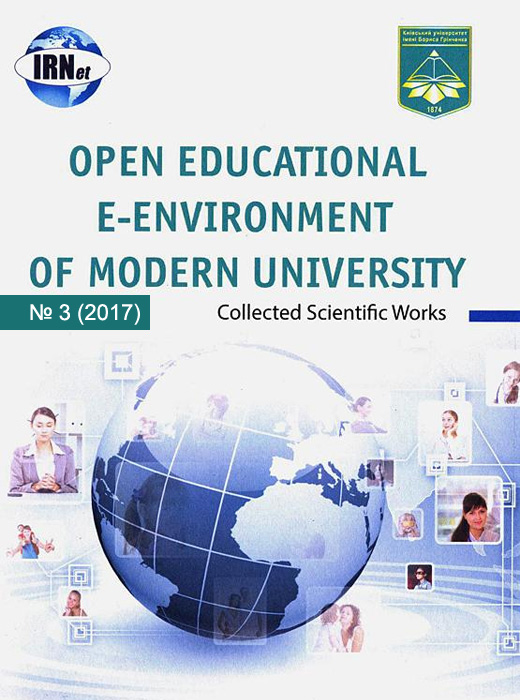A WAY TO MEASURE COMPLEX CONCEPTS RELATIONSHIPS WHEN USING DIGITAL STORYTELLING
Ключові слова:
digital storytelling, education, science network, digital stories, complex concepts relationshipsАнотація
In recent years the concept of digital narrative or Digital Storytelling has become one of the most effective techniques for educational systems. This, although being a classic theme, has recently been revitalized with the ease of making digital stories with current technologies, mainly by the profusion of tools accessible on the Internet under the Cloud Computing paradigm and the high integration of them, for their design, creation, publication and other actions that these well-known new technologies allow and, even more important, the communicative power that the multimedia elements provide to a classic story. Although there have been several and important efforts to structure the production of digital stories, analyzing the key points that the digital multimedia formats provide to the narrative and focusing on those emotional aspects or the research and synthesis skills that students develop, there are not any concrete systematized experience on how to use Digital Storytelling in classrooms to develop and teach specific topics in classrooms. And if they exist, a coherent and homogenous measurement method for assessing the specific contribution to student skills development is missing as digital stories are supposed to do. This research project aimed to explore the use of Digital Storytelling with in educational environments, designing and implementing digital stories about a specific topic concerning the Information Security subject, taught in the 3rd year Degree in Telecommunication and Computer Science Engineering, developing an assessment of the map of knowledge that the students owns about the selected topic before, during and after creating their digital stories. To do so, we have used qualitative data analysis techniques and Pathfinder networks to measure the similarity grade o distance between technical concepts, previously graded by the students in a continuous scale. Thus, the project is aimed to provide a way of measuring one of the skills likely developed by Digital Storytelling, according to the opinion of a great number of experts.
Завантаження
Посилання
Arias Masa, J. (2008). Evaluación de la calidad de Cursos Virtuales: Indicadores de Calidad y construcción de un cuestionario de medida. Aplicación al ámbito de asignaturas de Ingeniería Telemática. Badajoz: Universidad de Extremadura.
Casas, L. M. (2002). Redes Pathfinder.
Casas, L., Luengo, R., & Godinho, V. (2011). Software GOLUCA: Knowledge Representation in Mental Calculation. US-China Education Review, B4, 592-600.
Chung, S. (2007). Art Education Technology: Digital Storytelling. (S. U. James Haywood Rolling Jr., Ed.) Art Education, 60(2), 17-22.
Clarke, R., & Adam, A. (June de 2011). Digital storytelling in Australia. Academic perspectives and reflections. (A. a. Education, Ed.) SAGE Journals, 11(1-2), 157-176.
Contreras, J., Luengo, R., Arias, J, & Casas, L. (2015). Nuclearity indexes (full and reduced), as a contribution to the Theory of Nuclear Concepts. RISTI (Revista Iberica de Sistemas e Tecnologias de Informacao, E4, 16-35.
Fasi, M. (2011). Digital Storytelling in Education. (U. o. Kansas, Ed.)
Información, P. d. (2016). cum.unex.es. Recuperado el 16 de 6 de 2016, de Centro Universitario de Mérida: http://www.unex.es/conoce-la-uex/centros/cum/informacion- academica/programas-asignaturas/curso-2015-16/plan1515/501453.pdf
Isaacson, M. (2015). Digital-Storytelling for Apprenticeships in Sustainability Science and Engineering Design. 122nd ASEE Annual Conference & Exposition. American Society for Engineering Education.
Karakoyuna, F., & Kuzub, A. (2013). Examining Digital Storytelling In Terms of the 21 st Century Skills Development. TEL2013 Technology-enhanced Learning. Singapore.
Kordaki, M., & Psomos, P. (2015). A novel educational digital storytelling tool focusing on students misconceptions. Procedia-Social and Behavioral Sciences, 191, 82-86.
Lambert, J. (17 de February de 2007). Digital storytelling cookbook . (C. f. Berkeley, Ed.) Digital Diner Press.
Luengo , R., & Casas, L. (2004). Representación del conocimiento y aprendizaje. Teoría de los Conceptos Nucleares. Revista Española de pedagogía, 59-84.
Malita, L., & Martin, C. (2010). Digital Storytelling as web passport to success in the 21st Century. (H. Uzunboylu, Ed.) Procedia - Social and Behavioral Sciences, 2(2), 3060-3064.
Price, D., Strodtman, L., Brough, E., & Lonn, S. (2015). Digital storytelling: An innovative technological approach to nursing education. Nurse educator, 40(2), 66-70.
Robin, B. (2006). The educational uses of digital storytelling. Technology and teacher education annual, 1, 709.
Robin, B. (2008). Digital Storytelling: A Powerful Technology Tool for the 21st Century Classroom. Theory into practice, 47(3), 220-228.
Rodríguez, R. (2016). Teorías implícitas sobre evaluación en matemáticas que poseen los docentes en formación inicial de las universidades de Extremadura España y Trujillo Perú. Badajoz.
Sadik, A. (2008). Digital storytelling: A meaningful technology-integrated approach for engaged student learning. Educational technology research and development, 56(4), 487-506.
Sakka, Z., & Zualkernan, I. (2005). Digital Storytelling in Higher Education: A Case Study in a Civil Engineering Laboratory. En IEEE (Ed.), Fifth IEEE International Conference ICALT 2005, Advanced Learning Technologies, págs. 365-367.
Signes, C. (2010). Practical uses of digital storytelling. (U. d. Valencia., Ed.)
Yuksel, P., Robin, B., & McNeil, S. (2011). Educational uses of digital storytelling around the world.
Proceedings of Society for Information Technology & Teacher Education International Conference, 1, págs. 1264-1271.













1.jpg)








